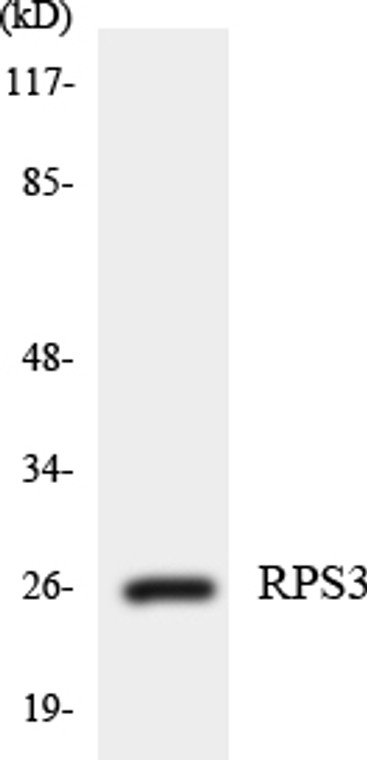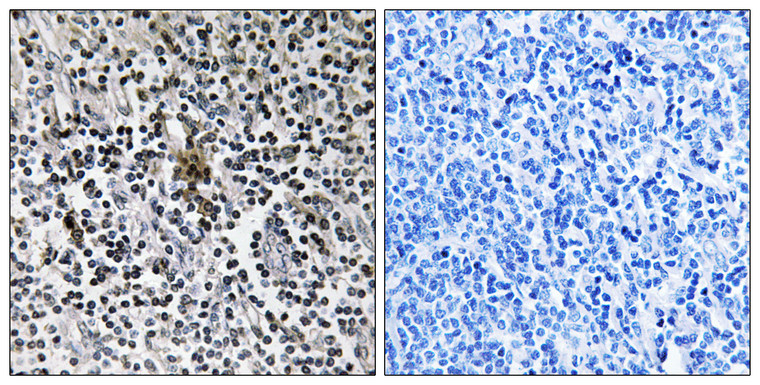| Host: |
Rabbit |
| Applications: |
WB/IHC/IF/ELISA |
| Reactivity: |
Human/Mouse/Rat |
| Note: |
STRICTLY FOR FURTHER SCIENTIFIC RESEARCH USE ONLY (RUO). MUST NOT TO BE USED IN DIAGNOSTIC OR THERAPEUTIC APPLICATIONS. |
| Short Description: |
Rabbit polyclonal antibody anti-Small ribosomal subunit protein uS3 (171-220 aa) is suitable for use in Western Blot, Immunohistochemistry, Immunofluorescence and ELISA research applications. |
| Clonality: |
Polyclonal |
| Conjugation: |
Unconjugated |
| Isotype: |
IgG |
| Formulation: |
Liquid in PBS containing 50% Glycerol, 0.5% BSA and 0.02% Sodium Azide. |
| Purification: |
The antibody was affinity-purified from rabbit antiserum by affinity-chromatography using epitope-specific immunogen. |
| Concentration: |
1 mg/mL |
| Dilution Range: |
WB 1:500-1:2000IHC 1:100-1:300ELISA 1:40000IF 1:50-200 |
| Storage Instruction: |
Store at-20°C for up to 1 year from the date of receipt, and avoid repeat freeze-thaw cycles. |
| Gene Symbol: |
RPS3 |
| Gene ID: |
6188 |
| Uniprot ID: |
RS3_HUMAN |
| Immunogen Region: |
171-220 aa |
| Specificity: |
Ribosomal Protein S3 Polyclonal Antibody detects endogenous levels of Ribosomal Protein S3 protein. |
| Immunogen: |
The antiserum was produced against synthesized peptide derived from the human RPS3 at the amino acid range 171-220 |
| Function | Component of the small ribosomal subunit. The ribosome is a large ribonucleoprotein complex responsible for the synthesis of proteins in the cell. Has endonuclease activity and plays a role in repair of damaged DNA. Cleaves phosphodiester bonds of DNAs containing altered bases with broad specificity and cleaves supercoiled DNA more efficiently than relaxed DNA. Displays high binding affinity for 7,8-dihydro-8-oxoguanine (8-oxoG), a common DNA lesion caused by reactive oxygen species (ROS). Has also been shown to bind with similar affinity to intact and damaged DNA. Stimulates the N-glycosylase activity of the base excision protein OGG1. Enhances the uracil excision activity of UNG1. Also stimulates the cleavage of the phosphodiester backbone by APEX1. When located in the mitochondrion, reduces cellular ROS levels and mitochondrial DNA damage. Has also been shown to negatively regulate DNA repair in cells exposed to hydrogen peroxide. Plays a role in regulating transcription as part of the NF-kappa-B p65-p50 complex where it binds to the RELA/p65 subunit, enhances binding of the complex to DNA and promotes transcription of target genes. Represses its own translation by binding to its cognate mRNA. Binds to and protects TP53/p53 from MDM2-mediated ubiquitination. Involved in spindle formation and chromosome movement during mitosis by regulating microtubule polymerization. Involved in induction of apoptosis through its role in activation of CASP8. Induces neuronal apoptosis by interacting with the E2F1 transcription factor and acting synergistically with it to up-regulate pro-apoptotic proteins BCL2L11/BIM and HRK/Dp5. Interacts with TRADD following exposure to UV radiation and induces apoptosis by caspase-dependent JNK activation. |
| Protein Name | Small Ribosomal Subunit Protein Us340s Ribosomal Protein S3 |
| Database Links | Reactome: R-HSA-156827Reactome: R-HSA-156902Reactome: R-HSA-1799339Reactome: R-HSA-192823Reactome: R-HSA-2408557Reactome: R-HSA-6791226Reactome: R-HSA-72649Reactome: R-HSA-72689Reactome: R-HSA-72695Reactome: R-HSA-72702Reactome: R-HSA-72706Reactome: R-HSA-72764Reactome: R-HSA-9010553Reactome: R-HSA-9633012Reactome: R-HSA-9735869Reactome: R-HSA-9754678Reactome: R-HSA-975956Reactome: R-HSA-975957 |
| Cellular Localisation | CytoplasmNucleusNucleolusMitochondrion Inner MembranePeripheral Membrane ProteinCytoskeletonSpindleIn Normal CellsLocated Mainly In The Cytoplasm With Small Amounts In The Nucleus But Translocates To The Nucleus In Cells Undergoing ApoptosisNuclear Translocation Is Induced By Dna Damaging Agents Such As Hydrogen PeroxideAccumulates In The Mitochondrion In Response To Increased Ros LevelsLocalizes To The Spindle During MitosisLocalized In Cytoplasmic Mrnp Granules Containing Untranslated Mrnas |
| Alternative Antibody Names | Anti-Small Ribosomal Subunit Protein Us3 antibodyAnti-40s Ribosomal Protein S3 antibodyAnti-RPS3 antibodyAnti-OK antibodyAnti-SW-cl.26 antibody |
Information sourced from Uniprot.org
12 months for antibodies. 6 months for ELISA Kits. Please see website T&Cs for further guidance










